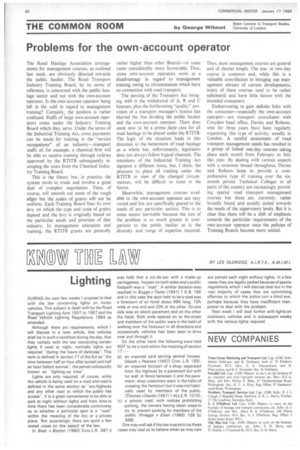Lighting
Page 62

If you've noticed an error in this article please click here to report it so we can fix it.
BY LES OLDRIDGE, DURING the next few weeks I propose to deal with the law concerning lights on motor vehicles. This subject is dealt with by the Road Transport Lighting Acts 1957 to 1967 and the Road Vehicle Lighting Regulations 1964 as amended.
Although there are requirements, which I will discuss in a later article, that vehicles shall be .in such a condition during the day, that they comply With the law concerning certain lights if used at night, normally lights are required "during the hours of darkness". This term is defined in section 17 of the Act as' the time between half an hour after sunset and half an hour before sunrise-, the period colloquially known as "lighting-up time".
Lights are only required, of course, while the vehicle is being used'on a road and road is defined in the same section as "any highway and any other road to which the public has access". It is a great convenience to be able to park at night without lights and from time to time there has been considerable controversy as to whether a particular spot is a "road" within the meaning of the Act or a private place. Not surprisingly there are quite a few stated cases on this aspect of the law.
In Bass v Boy-ton 11960) Crim.L.R. 497 it
was held that a cul-de-sac with a made-up carriageway, houses on both sides and a public footpath was a "road". A similar decision was reached in Bugge v Taylor i1941) 1 K.8. 198 and in this case the spot held to be a road was a forecourt of an hotel about 69ft long, 10ft wide at one end and 20ft at the other. On one side was an island pavement and on the other the hotel. Both ends opened on to the street and members of the public were in the habit of walking over the forecourt in all directions and occasionally vehicles had been seen to drive over and through it.
On the other hand the following were held NOT to be a road within the meaning of section 17 : — (a) an unpaved yard serving several houses. (Heath v Pearson (1957) Crim. L. R. 195); (b) an unpaved forcourt of a shop, separated from the highway by a pavement but with no wall or fence between it and the pavement; shop customers were in the habit of crossing the forecourt but it was not habitually used by members of the public. (Thomas vDando11951 ) 1 ALL E. R. 1010);
(c) a private road, with notices prohibiting parking, the owners having taken steps to try to prevent parking by members of the public (Knaggs v Elson 11965) 109 SJ 596).
One may well ask if the law is as strict as these cases may lead us to believe when so may cars are parked each night without lights. In a few cases they are legally parked because of special regulations which I will discuss later but in the vast majority of cases they are committing offences to which the police turn a blind eye, perhaps because they have insufficient manpower to deal with the problem.
Next week I will deal further with lights on stationary vehicles and in subsequent weeks with the various lights required.








































































































